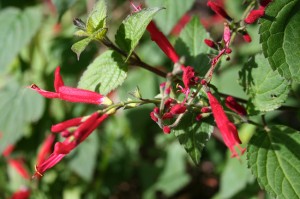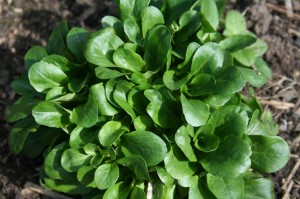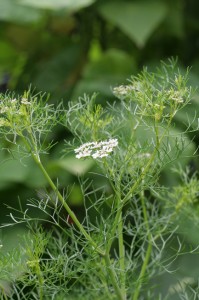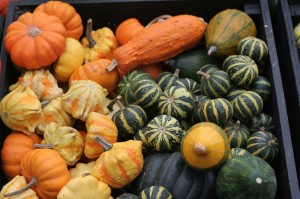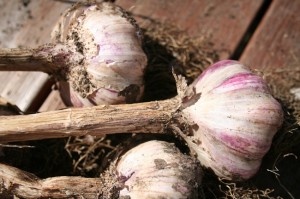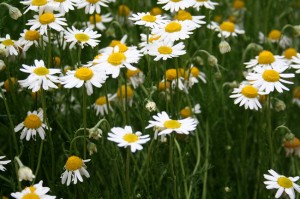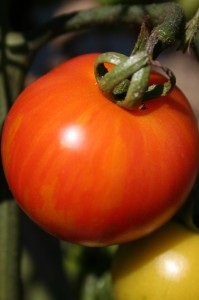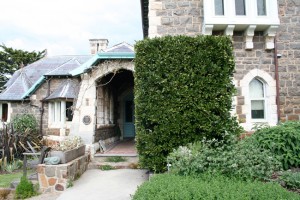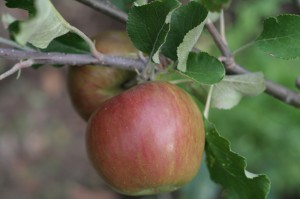At this time of year articles begin to proliferate describing plants you can grow that will lend splashes of colour to sombre autumn and winter days. As usual I am gaining much pleasure from the bright red flowers of pineapple sage (Salvia elegans). So too are the eastern spinebills who flash their tawny throats at me as they fossick for nectar. Also dog’s bane (so named because it’s ability to repel some dogs), Plectranthus ornatus, has been sporting its strong, mauve flowers for months now and will continue to do so right through winter. Really for me the colour highlights in late autumn and winter come from all the plants I haven’t planted, the ones that turn up whether you want them or not.
Continue Reading
The lovely autumn days entice me into the garden where I have been madly weeding and cutting back the prolific summer growth. I love this time of year when the soil is still warm, so plants are still growing, but the intense heat has gone. Two plants that come into their own now are corn salad and landcress. These are both annuals (landcress is sometimes biennial) that self sow around my garden providing salad greens right though autumn and winter.
Corn salad (Valerianella locusta) is also known as lamb’s lettuce, and has a delicate very mild flavour with soft leaves that almost melt in the mouth. The leaves are pale green and rounded and grow in small clumps. You can pick the leaves individually or cut whole plants just above the ground, they will re-shoot. Plants only reach about 30cm in height. There are cultivars with golden, extra large and darker green leaves. Grow corn salad in temperate and cold regions from seed sown in autumn, winter and spring—in hot weather it goes to seed almost immediately. I find that mine goes to seed in spring, then disappears until autumn when the plants appear again in a dense clump. Continue Reading
Coriander, also known as cilantro and Chinese parsley, is one of the most ancient herbs still in use today. It is also claimed by some to be the world’s most widely used herb. Whether this is true or not, coriander leaves and seeds are essential to the cuisine of central and southern America, South-East and northern Asia as well as India and the Middle East.
History
Coriander comes originally from southern Europe where the seeds have been used for centuries, but the leaves were not usually used. Coriander seeds have been found in Egyptian tombs dating from more than 3000 years ago. The Egyptians cultivated coriander in their gardens and offered it at funeral ceremonies. It was used by Hippocrates and other Greek physicians as early as the fifth century B. C., while the Chinese considered that coriander had the ability to bestow immortality. This plant has the distinction of being one of the few herbs mentioned in the Old Testament Num. 11:7
“Now the manna was like coriander seed.”
The botanical and common name, coriander, comes from the Greek word koris which means ‘bug’. This presumably relates to the fact that the smell and flavour of coriander has been unfavourably compared with that of stink bugs. Continue Reading
Last weekend saw a celebration of old cultivars and varieties of both fruit and vegetables. At Diggers Heronswood, Dromana it has been the Harvest Festival Weekend with a really beautiful array of pumpkins and squashes, garlic for sale and tomatoes to taste. Nearly all of these are heirloom or open pollinated varieties that are so important both for our gardening history and our future. Heirloom and heritage varieties are an integral part of organic gardening, many are the result of selective breeding over numerous generations so that they show special characteristics.
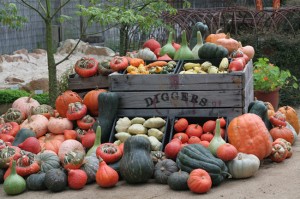
Turk's Turban, Delicata, Potimarron, Australian Butter, Buttercup and Bohemian are just a few of the heirloom varieties of pumpkins available to grow.
Now is the time to plant garlic. Don’ t wait until the shortest day as this is generally too late. Anytime from now until the end of May is fine.
I am planting some early garlic now, and in another month some of my home-grown from last year and a month after that some more. I want to make sure that I have my own fresh garlic available all year round.
Why grow your own?
— We are all used to the idea that tomatoes eaten straight from the garden taste so much better than the supermarket variety. Well the same is true for garlic.
— Garlic is easy to grow and takes up very little space.
— All imported garlic is sprayed with methyl bromide when it comes into Australia, not only does methyl bromide deplete ozone, but it is also harmful to humans. As well as this, much of our imported garlic comes from China where pesticides are routinely used, and only 5% of vegetables imported from China are checked for chemical residue. Continue Reading
Just as the success of a meal depends on the quality of the ingredients, so too does the success of a compost heap. If you add only kitchen scraps you’re likely to end up with a slimy, black mess and if it’s all leaves and twigs then the chances are that is what will still be there months later. The fine detail of a compost recipe varies depending on the expert you are consulting, but all compost systems require free drainage, adequate moisture and a mixture of strawy, open material and green plant tissue. The purpose of composting is to break down garden and kitchen ‘waste’ into humus that can then be added to the garden to supply nutrients in a form that can be readily used by plants. Continue Reading
By Anne-Marie
A FRIEND has just arrived with that most treasured of gifts, fresh tomatoes, bless her glut. Black Krims, Little Sugars, Tigerella and Cherry Toms surplus to her own requirements, and a generous handful of fresh basil. She has had a good tomato season (mine was awful: I planted them in the wrong place, neglected them badly and missed one of summer’s pleasures). She is one of those natural gardeners who can grow anything without much apparent effort, and she has been a source of wisdom for years.
So I have immediate plans for them, involving garlic and basil and crisp salad greens and some proper rustic croutons warm from the oven, with a herby dressing and some warm, thinly sliced rare beef scattered over the top, and the pan juices poured over to mingle with the dressing. A very satisfactory meal, as long as everything is properly seasoned with plenty of salt and pepper. I don’t hold with a lack of seasoning: flavour is all. Continue Reading
Sweet bay (Laurus nobilis ) was seen by the old herbalists as a virtuous tree which “resisteth witchcraft very potently”. The Greeks dedicated it to Apollo, the sun god. The Delphic priestesses, oracles of Apollo, held bay leaves between their lips as they made prophesies. In Greek and Roman cultures victors, heroes, academics and artistic figures were rewarded with a wreath or crown of bay leaves. This gave rise to the terms ‘baccalaureate’ and ‘poet laureate’. Continue Reading
This bountiful season of “mists and mellow fruitfulness” sees an abundance of ripe pome fruits on the trees. As well as the better known apples and pears there are also persimmons, pomegranates, quinces, rowans and rose hips.
Our supermarkets and greengrocers offer only about 5 varieties of apples and 3 different pears and we almost never see any of the other autumn fruits mentioned above. The obvious conclusion is that if you want really good fruit and anything other than these common varieties then you need to grow them yourself.
Although you can now buy potted fruit trees all year round, it’s best to use bare rooted apple and pear trees. These are purchased and planted in winter when you’ll find most nurseries offer at least a limited range. Autumn however, is the perfect time to plan your orchard (no matter how small), to taste the different varieties and to order your plants. At the National Trust Property, Rippon Lea, there is a large orchard of more than 100 different apples and 30 different pears. They have an Apple Day on Sunday 3rd of April 2011 when 40 of these varieties will be for sale, including some that are grown only for cider.
Apart from Rippon Lea, if you want something other than the more common varieties then you’ll need to order your trees from a specialist nursery. Continue Reading

